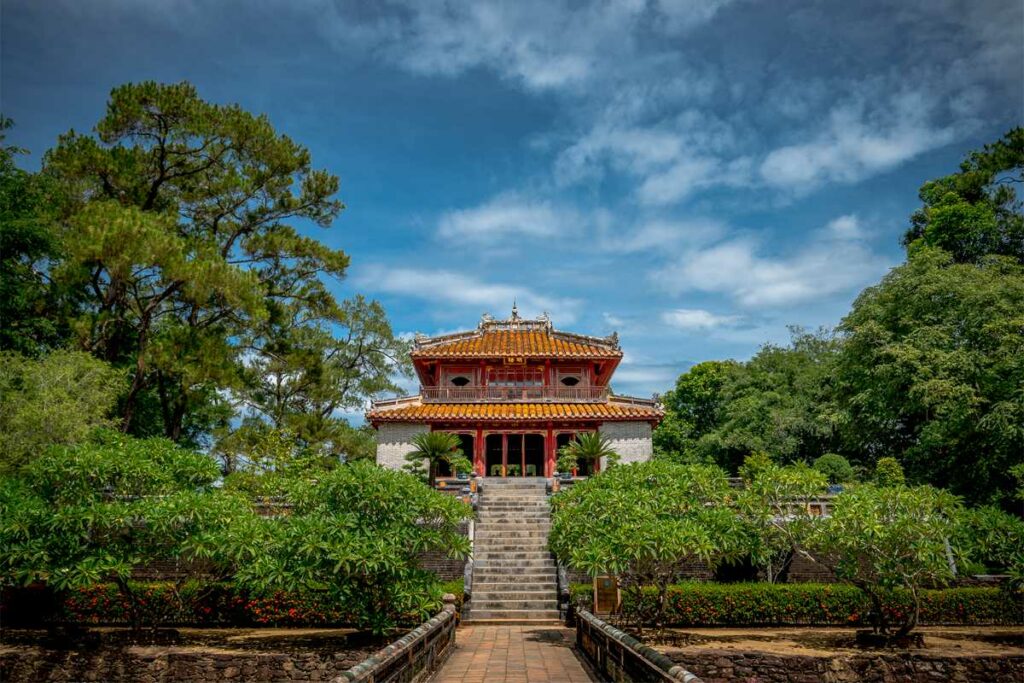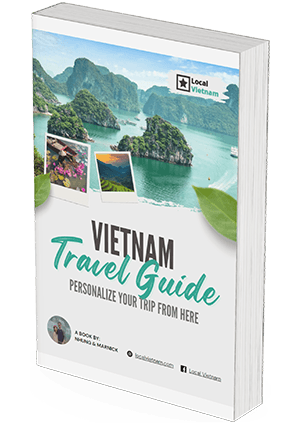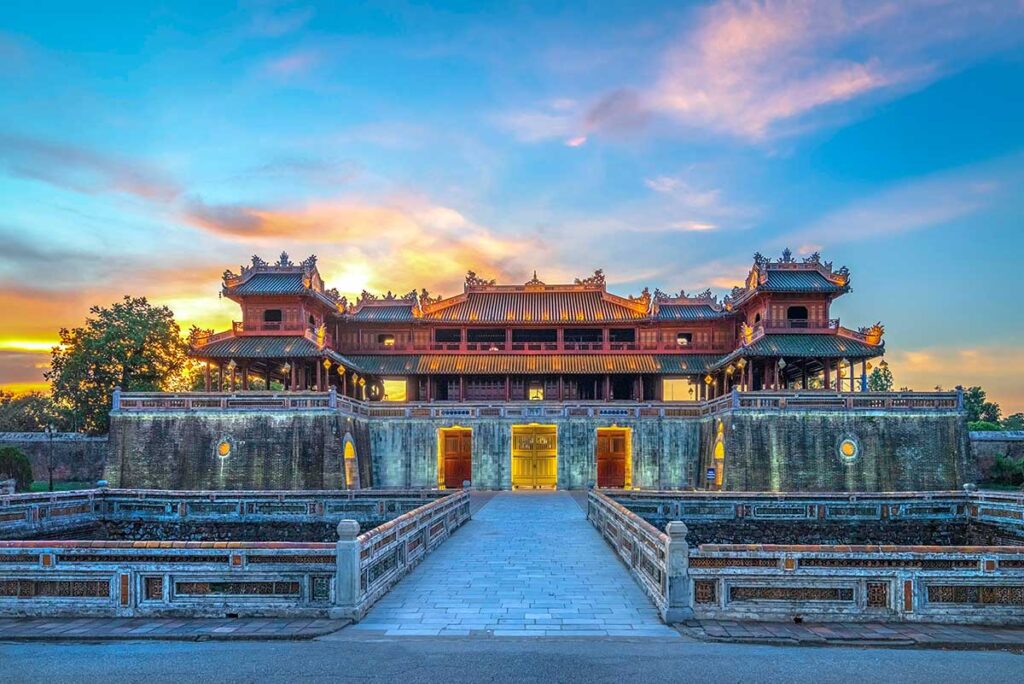What is Minh Mang Tomb?
The Tomb of Minh Mang is the royal mausoleum of Emperor Minh Mang, one of the rulers of Vietnam’s last imperial dynasty. It’s located about 12 kilometers from Hue, the former capital of the Nguyen Dynasty. Hue is known for its historic Imperial City and a series of ornate tombs built for the emperors who once ruled from there. The Mausoleum of Emperor Minh Mang is one of the most famous of these sites, set in a peaceful, scenic area surrounded by lakes, hills, and forest.

Who was emperor Minh Mang?
Emperor Minh Mang (1791–1841) was the second emperor of the Nguyen Dynasty and one of its most influential rulers. The son of Emperor Gia Long, he inherited the throne in 1820 and led Vietnam during a time of consolidation and internal reform. Minh Mang is best known for strengthening the monarchy, centralizing the administration, and promoting Confucianism as the core of Vietnamese governance. He reorganized provinces, built roads and canals, and reinforced traditional values through a strict moral code.
Minh Mang was also known for his resistance to Western influence. He firmly rejected French missionary efforts and limited foreign contact, setting the tone for Vietnam’s cautious stance toward outsiders in the decades to follow. Culturally, he supported literature, classical education, and Vietnamese architecture, leaving a lasting impact on national identity.
He fathered over 140 children and ruled for 21 years before dying unexpectedly at age 49. His sudden death came just as he was planning his final resting place—an imperial tomb that would reflect the harmony between man, nature, and power, later completed by his successor, Emperor Thieu Tri.
History of Minh Mang Tomb
The Tomb of Minh Mang was planned during the emperor’s lifetime, but he never saw it completed. In 1840, Emperor Minh Mang personally approved the location—a tranquil area where rivers, hills, and pine forests met—believing it reflected the perfect balance between nature and imperial order. Construction began that same year, but the emperor died suddenly in early 1841, before the tomb was finished. His son and successor, Emperor Thieu Tri, continued the work, and the Mausoleum of Emperor Minh Mang was completed in 1843, two years after his death.
The site was chosen not only for its natural beauty but also for its symbolic meaning. The layout reflects Minh Mang’s deeply Confucian worldview, where everything has its rightful place—both in life and after death. The tomb became a powerful statement of his authority, values, and the image he wanted to leave behind for future generations.
Highlights & architecture
The Tomb of Minh Mang is more than just a royal burial site—it’s a carefully planned architectural statement. When seen from above, the entire layout is designed to resemble a human body in repose, following strict principles of harmony between man and nature. This symbolic structure reflects Confucian ideals and Minh Mang’s belief in order, balance, and spiritual alignment.

The 700-meter-long central axis is like a spine, with key structures representing parts of the body:
- The head is the emperor’s actual burial site, high on a hill.
- The torso or heart is symbolized by Sung An Palace, the spiritual center.
- The neck is represented by the bridge connecting the living and spiritual realms.
- The arms are the lakes spreading out symmetrically on either side.
As you walk through the complex, you’re essentially following a path through this symbolic body. Here are the main highlights you’ll encounter along the way:
1. Dai Hong Mon Gate
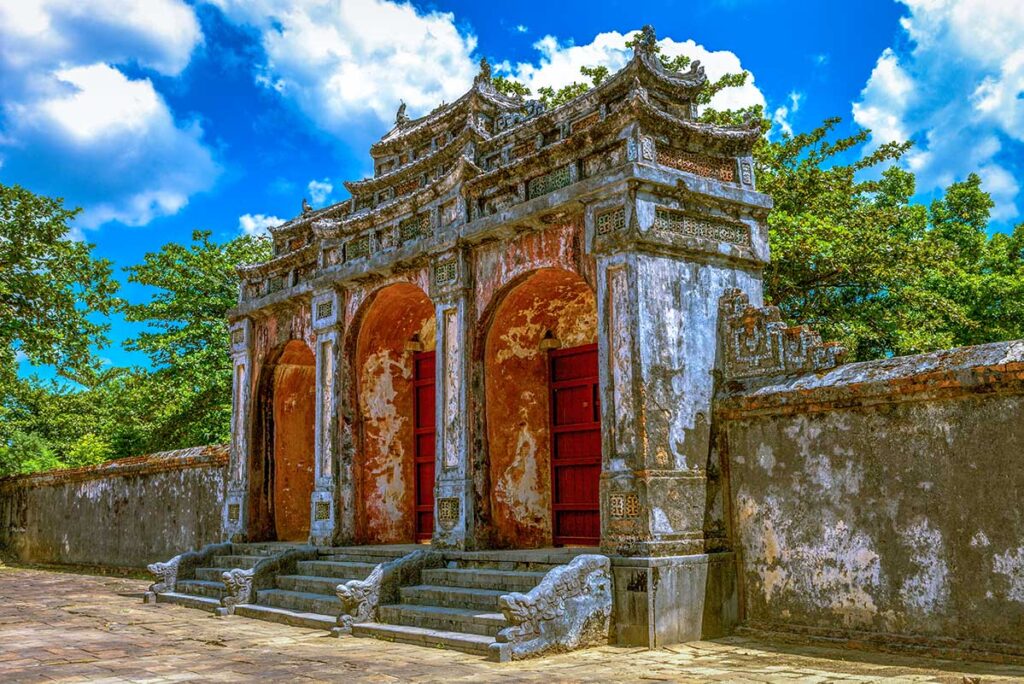
This is the main entrance to the mausoleum and the starting point of the central axis. Built of brick and stone with a tiled roof and subtle carvings of dragons and clouds, it reflects the authority of the emperor. The main gate remains closed—reserved for the emperor’s spirit—while visitors pass through smaller side gates.
2. Bai Dinh Yard
After the gate, you arrive at a large open courtyard paved with stone slabs. It may look simple, but it’s a key transitional space. Lined with plants and centered around a bronze cauldron once used for offerings, this yard serves as a quiet prelude before reaching the emperor’s official commemoration.
3. Honour courtyard
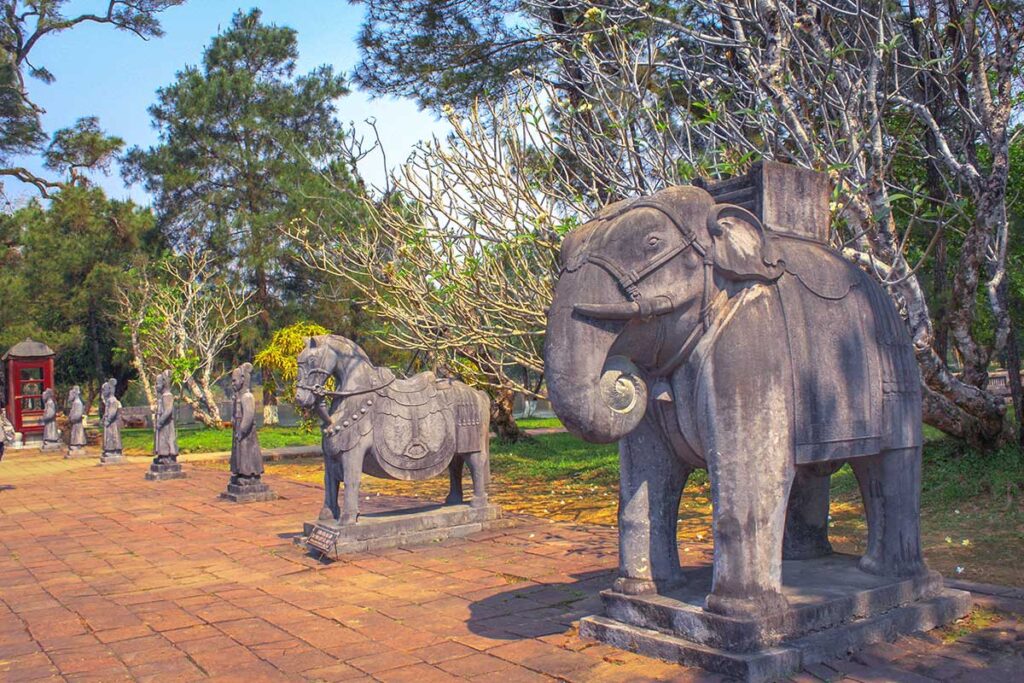
This open space is right attached to the Bai Dinh Yard and is guarded by stone statues of mandarins, elephants, horses, and soldiers—symbolic protectors of the emperor in the afterlife. Walking past them gives you a sense of stepping into a royal scene from the past, where spiritual duty and ceremony were part of everyday life.
4. Stele Pavilion (Bi Dinh)

This elegant structure houses a stone stele inscribed with Minh Mang’s life story, written by his son. With its graceful roof and central placement, the pavilion balances historical tribute with architectural beauty, marking a key point along the tomb’s symbolic spine.
5. Sung An Palace

This richly decorated temple represents the heart of the complex, both literally and symbolically. It’s where offerings were made and rituals conducted for the emperor’s spirit. Though you can’t go inside, the palace’s lacquered wood, tiled roof, and detailed carvings make it one of the most impressive structures here.
6. Tan Nguyet Lake
This crescent-shaped lake adds calm and beauty to the walk toward the emperor’s resting place. The layout of the lake mirrors a pair of outstretched arms, adding to the tomb’s human symbolism. It’s especially picturesque in the early morning or late afternoon, when the light softens across the water.
7. Thong Minh Chinh Truc Bridge
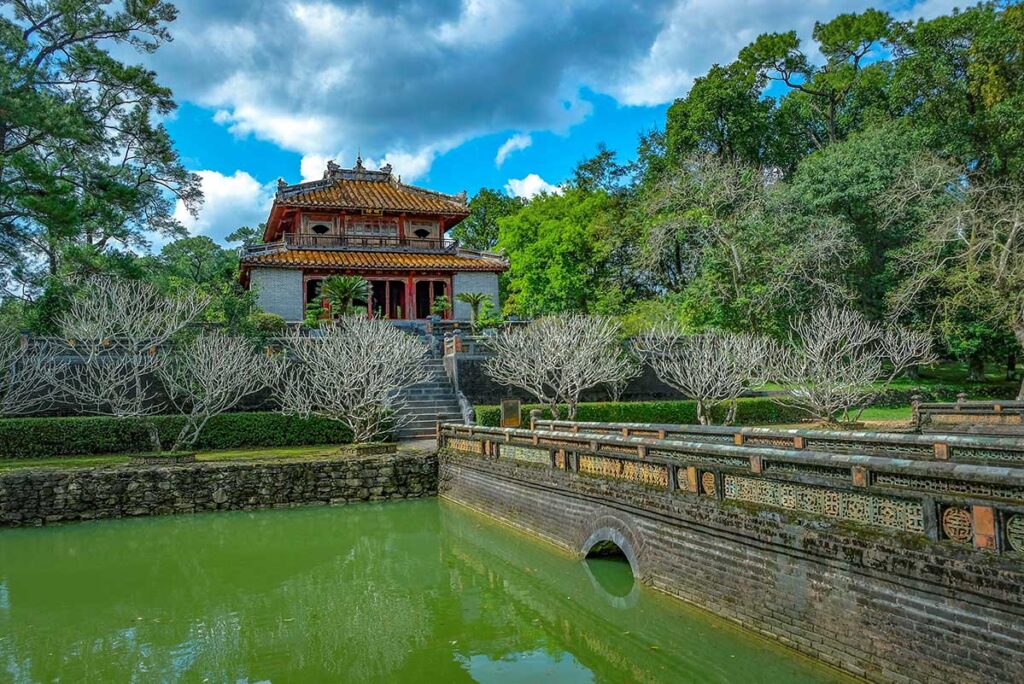
Also called the “Bridge of Intelligence on the Straight Path,” this structure crosses the lake and leads toward the final burial area. Symbolizing the neck in the tomb’s human layout, it acts as a spiritual passage between the ceremonial world and the afterlife.
8. Minh Lau Pavilion
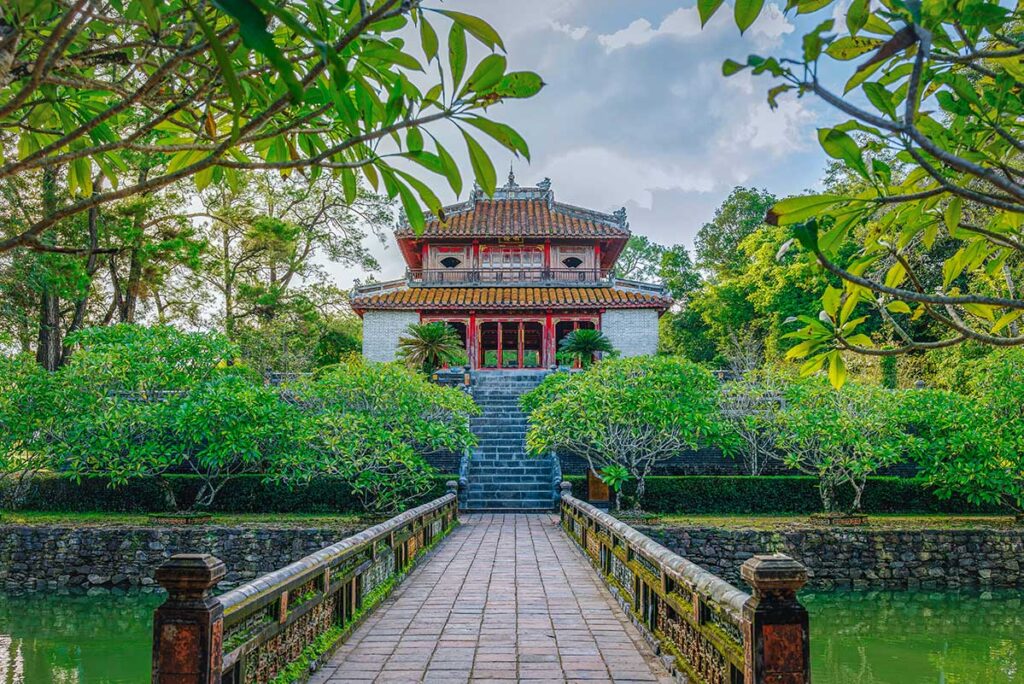
Translated as the “Pavilion of Light,” this small three-story tower sits on a hill just before the tomb area. It symbolizes enlightenment and learning—two values Emperor Minh Mang strongly believed in. From the top, you get one of the best views of the surrounding hills, trees, and water.
9. Hien Duc Mon Gate

This is the final gate before reaching the emperor’s burial site. Like the entrance gate, it’s made of stone and decorated with dragons and phoenixes, marking the threshold between the outer world and the sacred burial grounds.
10. Buu Thanh (Burial Site)
Located at the top of Khai Trach Hill, this is the most solemn part of the complex. The emperor’s tomb is enclosed by a circular stone wall, nestled among pine trees. Visitors can’t go inside, but you can approach respectfully and take in the quiet atmosphere. As the symbolic head of the whole complex, it brings the journey to a fitting end—private, peaceful, and deeply connected to nature.
Visiting information & Practical tips
Location
The Tomb of Minh Mang is situated in Huong Tho Commune, Huong Tra District, approximately 12 kilometers southwest of Hue city center. Nestled amidst pine-covered hills and near the Perfume River, the mausoleum offers a serene environment that reflects the emperor’s appreciation for harmony between architecture and nature.
Entrance fee
As of 2025, the entrance fees are:
- Adults: 150,000 VND
- Children (7–12 years old): 30,000 VND
- Children under 7: Free
Combo tickets are available if you plan to visit multiple royal tombs or the Imperial City, offering better value for extended sightseeing.
Opening times
The mausoleum is open daily from 7:00 AM to 5:00 PM. Arriving early in the morning or later in the afternoon is recommended to avoid peak visitor times and to enjoy the site in cooler temperatures.
Dress code
While there’s no strict dress code, it’s advisable to dress modestly out of respect for the cultural and historical significance of the site. Lightweight, breathable clothing that covers the shoulders and knees is appropriate, especially considering the warm climate and the amount of walking involved.
Guides
Visitors can explore the Mausoleum of Emperor Minh Mang independently; however, informational signage is limited. Hiring a local guide can enrich your experience by providing historical context and insights into the symbolism and significance of the site’s architecture and layout.
Nearby sights
- Mausoleum of Emperor Khai Dinh: Located en route from Hue to Minh Mang’s tomb, this mausoleum is known for its unique blend of Vietnamese and European architectural styles.
- Mausoleum of Emperor Gia Long: Situated further along the same route, this tomb is set in a tranquil, forested area and is less frequented by tourists, offering a peaceful experience.
Visiting these nearby sites can provide a broader understanding of the Nguyen Dynasty’s architectural evolution and the varying philosophies of its emperors.
How to get to Minh Mang Tomb?
Taxi or grab app
Taking a taxi or using the Grab app is one of the most convenient ways to reach the Tomb of Minh Mang from Hue city center. The journey typically takes about 20–30 minutes, depending on traffic.
- Taxi: Traditional taxis are readily available in Hue. It’s advisable to agree on a fare before starting the trip or ensure the meter is used. A round-trip, including waiting time, might cost around 550,000 VND for a 4-hour trip covering multiple tombs.
- Grab App: Grab operates in Hue, offering both car and motorbike options. The app provides upfront pricing, which can be more convenient. However, availability might be limited in remote areas, so it’s recommended to arrange for the driver to wait during your visit or schedule a return trip in advance.
Cycling or scooter
For the more adventurous, renting a bicycle or scooter offers flexibility and the opportunity to explore at your own pace.
- Cycling: The 12 km ride from Hue to the tomb is scenic but can be challenging due to the heat and traffic. Ensure you’re prepared with water and sun protection.
- Scooter: Renting a scooter is a popular option, allowing you to visit multiple sites in a day. Be cautious of local traffic rules and road conditions.
Dragon boat
The Tomb of Minh Mang is accessible via the Perfume River, making a dragon boat ride a unique and picturesque option.
- Private Dragon Boat: You can arrange a private dragon boat from the city center’s docking area. The journey offers serene views of the river and surrounding landscapes. It’s advisable to negotiate the price and itinerary beforehand.
- Group Tours: Some group tours include a short dragon boat ride, typically from the city center to Thien Mu Pagoda. However, not all extend the journey to Minh Mang Tomb, so confirm the itinerary in advance.
Tour
Joining a tour can provide a comprehensive and informative experience.
- Group Tours: These are cost-effective and often include multiple sites, such as the Imperial City, Thien Mu Pagoda, and various royal tombs. They may offer a brief dragon boat ride as part of the itinerary.
- Private Tours: For a more personalized experience, private tours allow you to customize your itinerary, spend more time at preferred sites, and often include knowledgeable guides who provide in-depth historical context. Private tours can also arrange for a dragon boat ride directly to the tomb.
Each transportation option offers a different experience, so choose the one that best fits your preferences and schedule.
Hue Historical City Tour By Small Group or Private Tour
- Includes: Hue Imperial City, royal tombs, and a scenic dragon boat ride.
- Flexibility: Private option lets you customize the itinerary to your interests.
More historical sights in Hue
While the Tomb of Minh Mang is one of the most impressive royal sites in Hue, it’s just one part of a much larger historical landscape. As the former capital of the Nguyen Dynasty, Hue is home to an exceptional concentration of tombs, temples, and imperial monuments. Exploring more of these sites helps you better understand Vietnam’s last royal era and the cultural legacy it left behind.
- Hue Imperial City – A large walled citadel and palace complex in the city center, once the seat of the Nguyen emperors. Includes gates, temples, and restored royal buildings.
- Tomb of Tu Duc – Peaceful and poetic tomb surrounded by pine trees and lotus ponds. Built as a retreat during the emperor’s lifetime.
- Tomb of Gia Long – The most remote of the royal tombs, located in a quiet forest setting. Less visited, but ideal for travelers seeking a tranquil experience.
- Tomb of Khai Dinh – A unique blend of Vietnamese and French architecture, known for its colorful mosaic interior and dramatic hillside setting.
- Thien Mu Pagoda – A riverside Buddhist pagoda with a tall octagonal tower. One of the oldest and most iconic religious sites in Hue.
